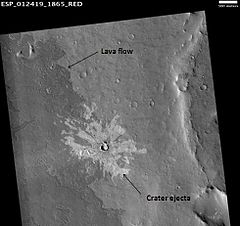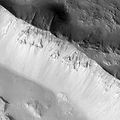亞馬遜紀
| 亞馬遜紀 | |
|---|---|
| 2000 – 0 百萬年前 (下邊界不確定- 大約介於32和20億年前) | |
 | |
| 具體信息 | |
| 天體 | 火星 |
| 適用時標 | 火星地質年代 |
| 定義 | |
| 地質年代單位 | 紀 |
| 年代地層單位 | 系 |
| 典型部位 | 亞馬遜平原 |
亞馬遜(Amazonian)是火星上一個地質系統和地質年代,其特徵是隕石和小行星撞擊率非常低,極度乾燥、寒冷的環境與今天火星上的情況大致相似[1][2]。它與前一期的赫斯珀里亞紀過渡有些模糊,被認為約開始於30億年前,儘管這一日期的誤差非常大(約5億年)[3]。有時,亞馬遜紀又被細分為早、中和晚亞馬遜世,亞馬遜紀一直延續到今天。
亞馬遜紀時期主要是撞擊坑的形成和風成作用,在塔爾西斯和科柏洛斯槽溝持續發生孤立的火山活動,包括後者在數萬年前[4]和奧林帕斯山過去幾百萬年內的活動跡象,這意味着它們仍然可能活躍,只是目前處於休眠狀態[5]。
名稱來源及描述[編輯]
「亞馬遜」系和「亞馬遜」紀是以隕坑分佈稀疏的亞馬遜平原所命名,這種稀疏的隕坑密度代表了許多亞馬遜紀時期的地表。亞馬遜系的典型地貌區約位於亞馬遜區(MC-8)北緯15度、西經158度附近。

亞馬遜年代和地層[編輯]

由於它是火星地質時期中最年輕的一段,亞馬遜紀的年表通過傳統地質疊覆律結合撞擊坑計數的相對測年技術得到了比較好的理解。亞馬遜紀隕石坑稀疏的特點也意味着,與古老年代不同,它的表面精細特徵(尺寸<100米)都得以保留[6]。由於火星表面必要的形態細節仍然清晰可見,這將可能對許多亞馬遜紀時代火星表面的特徵進行詳細的、面向過程的研究。
此外,這一相對年輕的時期意味着仍有可能重建太陽、火星和木星在過去1億年中的軌道力學統計數據,而不會被混沌效應所混淆,並由此再現太陽輻射量的變化-隨時間推移抵達火星的太陽熱量 [7]。火星上周期性發生的氣候變化已證明在規模量級和持續時間上與地球米蘭科維奇循環基本沒有差異。
總之,這些保存良好的特徵以及對所接收到的太陽光通量的理解—意味着對火星亞馬遜紀的許多研究都集中在了解其氣候和地表運動過程對氣候的響應,這包括:
- 冰川動態和地貌[8];
- 火星上冰的消漲[9];
- 地面冰的性狀及其產生的冰緣形式[10];
- 融化過程和小型河流地貌[11][12];
- 大氣層特性的變化[13];
- 地下水動態[14];
- 冰蓋動態[15];
- 二氧化碳霜凍動態以及與之相關的奇異表面特徵,如「蜘蛛」[16];
- 風對沙和塵沉積物的作用以及常規風成沉積[17][18];
- 過去氣候環境(風場、溫度、雲層特性、大氣化學)本身的建模[19][20]。
良好的保存狀況,也使人們能夠對亞馬遜紀火星上的其他地質過程進行詳細研究,特別是火山活動[21][22][23]、脆性構造[24][25]和隕坑的形成等[26][27][28]。
系統與年代[編輯]
| 年代地層學中的岩(岩層)段 | 地質年代學中的時間跨度 | 備註(火星) |
|---|---|---|
| 宇 | 宙 | 不用於火星。 |
| 界 | 代 | 不用於火星。 |
| 系 | 紀 | 總計3種,長約108至109年。 |
| 統 | 世 | 總計8種,長約107至108年。 |
| 階 | 期 | 不用於火星。 |
| 帶 | 時 | 小於期/階;非國際地層委員會所用時標。 |
「系」和「紀」在正式地層命名法中是不可互換的,儘管它們在流行讀物中經常被混淆。系是一種理想化的地層柱,它基於某一典型區域(典型剖面)的物理岩石記錄,這一記錄與全球許多不同位置的岩石剖面相關聯[30]。一種系與上下相鄰的邊界地層有明顯不同的特徵(在地球上,通常是標準化石),表明主要動物群或環境條件發生了顯著(通常為突發性的)改變(參見白堊紀-古近紀邊界示例)。
在任何地方,給定地層系中的岩石剖面都容易包含空隙(不一致),就像書中的缺頁。在某些地方,由於未產生沉積或後來的侵蝕,該系中的岩石完全缺失。例如,美國中東部內陸大部分地區都不存在白堊紀系的岩石,但是,那裏肯定仍經歷過白堊紀時期。因此,地質時期代表形成該地層系的沉積時段,且包含所有空隙中存在的未知時長[30]。時期以年為單位,由放射性定年確定。在火星上,除了來源於地層背景未知的火星隕石外,無法獲得放射性年齡。相反,火星上的絕對年齡是由撞擊坑密度決定的,這在很大程度上取決於隨時間變化的隕石坑形成模型[31]。因此,火星各時期準確的開始和結束時間都無法確定,尤其是赫斯珀里亞/亞馬遜邊界,其誤差可能達到2或3倍[32][33]。
圖集[編輯]
-
高解像度成像科學設備觀察到的亞馬遜時期的底座形撞擊坑,帶有深色斜坡條紋。
-
高解像度成像科學設備觀察到的佩蒂特隕擊坑坑壁。
-
高解像度成像科學設備觀察到的帶有黑色條紋的尼克爾森丘。
-
高解像度成像科學設備所看到的馬爾提谷中的流線型島。
-
高解像度成像科學設備觀察到的裂縫通道。
-
高解像度成像科學設備觀察到的狹窄山脊。
-
高解像度成像科學設備所看到的亞馬遜區地表。
另請查看[編輯]
備註和參引[編輯]
- ^ Tanaka, K.L. (1986). The Stratigraphy of Mars. J. Geophys. Res., Seventeenth Lunar and Planetary Science Conference Part 1, 91(B13), E139–E158.
- ^ Carr, M.H. (2006), The Surface of Mars. Cambridge Planetary Science Series, Cambridge University Press.
- ^ Werner, S. C., and K. L. Tanaka (2011), Redefinition of the crater-density and absolute-age boundaries for the chronostratigraphic system of Mars, Icarus, 215(2), 603–607, doi:10.1016/j.icarus.2011.07.024.
- ^ Horvath, David G.; et al. Evidence for geologically recent explosive volcanism in Elysium Planitia, Mars. 11 November 2020. arXiv:2011.05956v1
 [astro-ph.EP].
[astro-ph.EP].
- ^ Martel, Linda M. V. Recent Activity on Mars: Fire and Ice. Planetary Science Research Discoveries. 2005-01-31 [2006-07-11]. (原始內容存檔於2011-01-22).
- ^ Irwin, R.P., Tanaka, K.L., and Robbins, S.J., 2013, Distribution of Early, Middle, and Late Noachian cratered surfaces in the Martian highlands: Implications for resurfacing events and processes: Journal of Geophysical Research, v. 118, p. 278–291, doi:10.1002/jgre.20053.
- ^ Laskar, J., Correia, A.C.M., Gastineau, M., Joutel, F., Levrard, B., and Robutel, P., 2004, Long term evolution and chaotic diffusion of the insolation quantities of Mars: Icarus, v. 170, no. 2, p. 343–364, doi:10.1016/j.icarus.2004.04.005.
- ^ Dickson, J.L., Head, J.W., III, and Marchant, D.R., 2010, Kilometer-thick ice accumulation and glaciation in the northern mid-latitudes of Mars: Evidence for crater-filling events in the Late Amazonian at the Phlegra Montes: Earth and Planetary Science Letters, v. 294, no. 3-4, p. 332–342, {doi|10.1016/j.epsl.2009.08.031}}.
- ^ Head, J.W., III, Mustard, J.F., Kreslavsky, M.A., Milliken, R.E., and Marchant, D.R., 2003, Recent ice ages on Mars: Nature, v. 426, p. 797–802.
- ^ Levy, J.S., Head, J.W., III, and Marchant, D.R., 2009, Concentric crater fill in Utopia Planitia: History and interaction between glacial 「brain terrain」 and periglacial mantle processes: Icarus, v. 202, p. 462–476, doi:10.1016/j.icarus.2009.02.018.
- ^ Fassett, C.I., Dickson, J.L., Head, J.W., III, Levy, J.S., and Marchant, D.R., 2010, Supraglacial and proglacial valleys on Amazonian Mars: Icarus, v. 208, no. 1, p. 86–100, doi:10.1016/j.icarus.2010.02.021.
- ^ Salese, F., G. Di Achille, A. Neesemann, G. G. Ori, and E. Hauber (2016), Hydrological and sedimentary analyses of well-preserved paleofluvial-paleolacustrine systems at Moa Valles, Mars, J. Geophys. Res. Planets, 121, 194–232, doi:10.1002/2015JE004891.
- ^ Leblanc, F., and R. E. Johnson. "Role of molecular species in pickup ion sputtering of the Martian atmosphere." Journal of Geophysical Research: Planets (1991–2012) 107.E2 (2002): 5-1.
- ^ Burr, D.M., Grier, J.A., McEwen, A.S., and Keszthelyi, L.P., 2002, Repeated Aqueous Flooding from the Cerberus Fossae: Evidence for Very Recently Extant, Deep Groundwater on Mars: Icarus, v. 159, no. 1, p. 53–73, doi:10.1006/icar.2002.6921.
- ^ Kolb, Eric J., and Kenneth L. Tanaka. "Geologic history of the polar regions of Mars based on Mars Global Surveyor data: II. Amazonian Period." Icarus 154.1 (2001): 22-39.
- ^ Kieffer, Hugh H., Philip R. Christensen, and Timothy N. Titus. "CO2 jets formed by sublimation beneath translucent slab ice in Mars' seasonal south polar ice cap." Nature 442.7104 (2006): 793-796.
- ^ Balme, Matt, et al. "Transverse aeolian ridges (TARs) on Mars." Geomorphology 101.4 (2008): 703-720.
- ^ Basu, Shabari, Mark I. Richardson, and R. John Wilson. "Simulation of the Martian dust cycle with the GFDL Mars GCM." Journal of Geophysical Research: Planets (1991–2012) 109.E11 (2004).
- ^ Read, Peter L., and Stephen R. Lewis. The Martian climate revisited: Atmosphere and environment of a desert planet. Springer Verlag, 2004.
- ^ Jakosky, Bruce M., and Roger J. Phillips. "Mars' volatile and climate history." nature 412.6843 (2001): 237-244.
- ^ Mangold, N., et al. "A Late Amazonian alteration layer related to local volcanism on Mars." Icarus 207.1 (2010): 265-276.
- ^ Hartmann, William K., and Daniel C. Berman. "Elysium Planitia lava flows: Crater count chronology and geological implications." Journal of Geophysical Research: Planets (1991–2012) 105.E6 (2000): 15011-15025.
- ^ Neukum, Gerhard, et al. "Recent and episodic volcanic and glacial activity on Mars revealed by the High Resolution Stereo Camera." Nature 432.7020 (2004): 971-979.
- ^ Márquez, Álvaro, et al. "New evidence for a volcanically, tectonically, and climatically active Mars." Icarus 172.2 (2004): 573-581.
- ^ Mueller, Karl, and Matthew Golombek. "Compressional structures on Mars." Annu. Rev. Earth Planet. Sci. 32 (2004): 435-464.
- ^ Robbins, Stuart J., and Brian M. Hynek. "Distant secondary craters from Lyot crater, Mars, and implications for surface ages of planetary bodies." Geophysical Research Letters 38.5 (2011).
- ^ Malin, Michael C., et al. "Present-day impact cratering rate and contemporary gully activity on Mars." science 314.5805 (2006): 1573-1577.
- ^ Popova, Olga, Ivan Nemtchinov, and William K. Hartmann. "Bolides in the present and past Martian atmosphere and effects on cratering processes." Meteoritics & Planetary Science 38.6 (2003): 905-925.
- ^ 國際地層委員會. 国际地层图 (PDF). [2009-09-25].
- ^ 30.0 30.1 Eicher, D.L.; McAlester, A.L. (1980).History of the Earth; Prentice-Hall: Englewood Cliffs, NJ, pp 143-146, ISBN 0-13-390047-9.
- ^ Masson, P.; Carr, M.H.; Costard, F.; Greeley, R.; Hauber, E.; Jaumann, R. (2001). Geomorphologic Evidence for Liquid Water. Space Science Reviews, 96, p. 352.
- ^ Nimmo, F.; Tanaka, K. (2005). Early Crustal Evolution of Mars. Annu. Rev. Earth Planet. Sci., 33, 133–161.
- ^ Hartmann, W.K.; Neukum, G. (2001). Cratering Chronology and Evolution of Mars. In Chronology and Evolution of Mars, Kallenbach, R. et al. Eds., Space Science Reviews, 96: 105–164.
參考書目和推薦閱讀[編輯]
- Boyce, Joseph, M. (2008). The Smithsonian Book of Mars; Konecky & Konecky: Old Saybrook, CT, ISBN 978-1-58834-074-0
- Carr, Michael, H. (2006). The Surface of Mars; Cambridge University Press: Cambridge, UK, ISBN 978-0-521-87201-0.
- Hartmann, William, K. (2003). A Traveler’s Guide to Mars: The Mysterious Landscapes of the Red Planet; Workman: New York, ISBN 0-7611-2606-6.
- Morton, Oliver (2003). Mapping Mars: Science, Imagination, and the Birth of a World; Picador: New York, ISBN 0-312-42261-X.
| ||||||||||||||||||||||||||||||||||||||||||||||||||||||||||||||||||||||||||||||||||||||||








